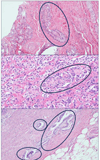Perineural Invasion and Risk of Lethal Prostate Cancer
- PMID: 28062398
- PMCID: PMC5413395
- DOI: 10.1158/1055-9965.EPI-16-0237
Perineural Invasion and Risk of Lethal Prostate Cancer
Abstract
Background: Prostate cancer has a propensity to invade and grow along nerves, a phenomenon called perineural invasion (PNI). Recent studies suggest that the presence of PNI in prostate cancer has been associated with cancer aggressiveness.Methods: We investigated the association between PNI and lethal prostate cancer in untreated and treated prostate cancer cohorts: the Swedish Watchful Waiting Cohort of 615 men who underwent watchful waiting, and the U.S. Health Professionals Follow-Up Study of 849 men treated with radical prostatectomy. One pathologist performed a standardized histopathologic review assessing PNI and Gleason grade. Patients were followed from diagnosis until metastasis or death.Results: The prevalence of PNI was 7% and 44% in the untreated and treated cohorts, respectively. PNI was more common in high Gleason grade tumors in both cohorts. PNI was associated with enhanced tumor angiogenesis, but not tumor proliferation or apoptosis. In the Swedish study, PNI was associated with lethal prostate cancer [OR 7.4; 95% confidence interval (CI), 3.6-16.6; P < 0.001]. A positive, although not statistically significant, association persisted after adjustment for age, Gleason grade, and tumor volume (OR 1.9; 95% CI, 0.8-5.1; P = 0.17). In the U.S. study, PNI predicted lethal prostate cancer independent of clinical factors (HR 1.8; 95% CI, 1.0, 3.3; P =0.04).Conclusions: These data support the hypothesis that perineural invasion creates a microenvironment that promotes cancer aggressiveness.Impact: Our findings suggest that PNI should be a standardized component of histopathologic review, and highlights a mechanism underlying prostate cancer metastasis. Cancer Epidemiol Biomarkers Prev; 26(5); 719-26. ©2017 AACR.
©2017 American Association for Cancer Research.
Conflict of interest statement
Figures
Similar articles
-
The relationship between perineural invasion, tumor grade, reactive stroma and prostate cancer-specific mortality: A clinicopathologic study on a population-based cohort.Prostate. 2016 Feb;76(2):207-14. doi: 10.1002/pros.23112. Epub 2015 Oct 19. Prostate. 2016. PMID: 26477789
-
Investigating association of perineural invasion on prostate biopsy with Gleason score upgrading at prostatectomy: A multi-institutional analysis.Cancer Med. 2020 May;9(10):3383-3389. doi: 10.1002/cam4.2920. Epub 2020 Mar 18. Cancer Med. 2020. PMID: 32187859 Free PMC article.
-
Evidence of perineural invasion on prostate biopsy specimen and survival after radical prostatectomy.Urology. 2013 Feb;81(2):354-7. doi: 10.1016/j.urology.2012.09.034. Urology. 2013. PMID: 23374801
-
Impact of biopsy perineural invasion on the outcomes of patients who underwent radical prostatectomy: a systematic review and meta-analysis.Scand J Urol. 2019 Oct;53(5):287-294. doi: 10.1080/21681805.2019.1643913. Epub 2019 Aug 10. Scand J Urol. 2019. PMID: 31401922
-
Perineural invasion-associated biomarkers for tumor development.Biomed Pharmacother. 2022 Nov;155:113691. doi: 10.1016/j.biopha.2022.113691. Epub 2022 Sep 12. Biomed Pharmacother. 2022. PMID: 36095958 Review.
Cited by
-
Investigation of Neural Microenvironment in Prostate Cancer in Context of Neural Density, Perineural Invasion, and Neuroendocrine Profile of Tumors.Front Oncol. 2021 Jul 1;11:710899. doi: 10.3389/fonc.2021.710899. eCollection 2021. Front Oncol. 2021. PMID: 34277455 Free PMC article.
-
Metabolic reprogramming and therapeutic resistance in primary and metastatic breast cancer.Mol Cancer. 2024 Nov 21;23(1):261. doi: 10.1186/s12943-024-02165-x. Mol Cancer. 2024. PMID: 39574178 Free PMC article. Review.
-
Single-nucleotide polymorphism rs13426236 contributes to an increased prostate cancer risk via regulating MLPH splicing variant 4.Mol Carcinog. 2020 Jan;59(1):45-55. doi: 10.1002/mc.23127. Epub 2019 Oct 29. Mol Carcinog. 2020. PMID: 31659808 Free PMC article.
-
The Role of Perineural Invasion in Prostate Cancer and Its Prognostic Significance.Cancers (Basel). 2022 Aug 23;14(17):4065. doi: 10.3390/cancers14174065. Cancers (Basel). 2022. PMID: 36077602 Free PMC article. Review.
-
Lymphovascular or perineural invasion is associated with lymph node metastasis and survival outcomes in patients with gastric cancer.Cancer Med. 2023 Apr;12(8):9401-9408. doi: 10.1002/cam4.5701. Epub 2023 Mar 23. Cancer Med. 2023. PMID: 36952439 Free PMC article.
References
-
- Pennington JW, Prentiss RJ, Howe G. Radical prostatectomy for cancer: significance of perineural lymphatic invasion. J Urol. 1967;97:1075–1077. - PubMed
-
- Villers A, McNeal JE, Redwine EA, Freiha FS, Stamey TA. The role of perineural space invasion in the local spread of prostatic adenocarcinoma. J Urol. 1989;142:763–768. - PubMed
-
- Liebig C, Ayala G, Wilks JA, Berger DH, Albo D. Perineural invasion in cancer: a review of the literature. Cancer. 2009;115:3379–3391. - PubMed
-
- Fromont G, Godet J, Pires C, Yacoub M, Dore B, Irani J. Biological significance of perineural invasion (PNI) in prostate cancer. Prostate. 2012;72:542–548. - PubMed
-
- Ayala GE, Wheeler TM, Shine HD, Schmelz M, Frolov A, Chakraborty S, et al. In vitro dorsal root ganglia and human prostate cell line interaction: redefining perineural invasion in prostate cancer. Prostate. 2001;49:213–223. - PubMed
Publication types
MeSH terms
Grants and funding
LinkOut - more resources
Full Text Sources
Other Literature Sources
Medical


